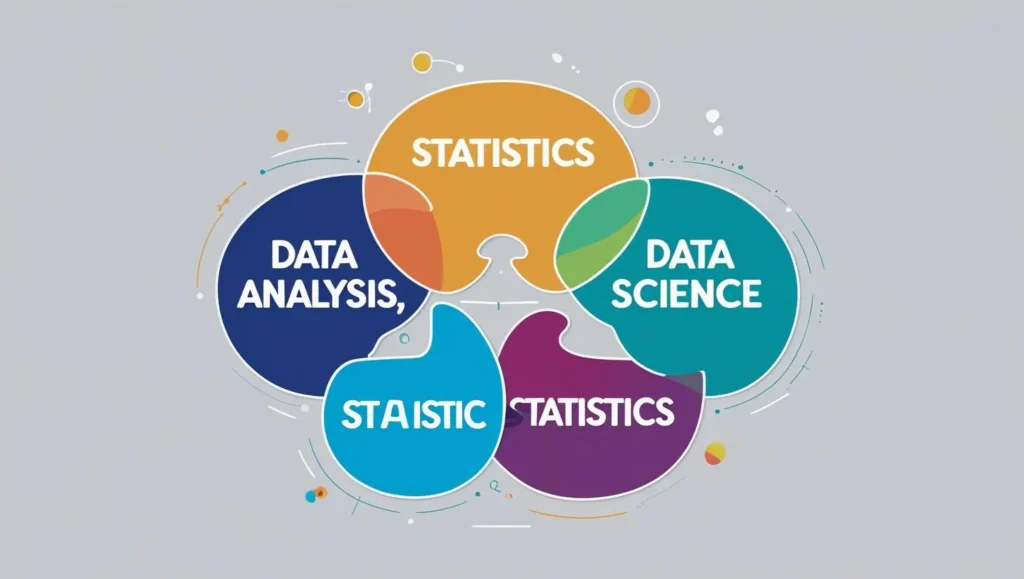
In today’s data-driven world, terms like Statistics, Data Analysis, and Data Science are often used interchangeably. But each one is a different field, with their own way of working, tools, and goals. As a student, corporate executive, or interested learner, knowing what differs between these three is important for you to be able to enjoy analytics today.
In this blog, we’ll break down what each field entails, how they relate to one another, and where they diverge—so you can better apply them in business, research, or technology.
/
What is Statistics?
All quantitative research is based on statistics. It’s a mathematical field focused on data gathering, organization, analysis, interpretation, and communication.
It’s a branch of mathematics that’s concerned with the gathering, structuring, examination, interpretation, and dissemination of data.
Key Objectives of Data Analysis:
- Summarizing significant data sets (Descriptive statistics)
- Drawing conclusions or forecasts (inferential statistics)
- Estimating uncertainties and modeling probabilities
Tools and Techniques:
- Mean, median, mode
- Standard deviation, variance
- Models of regression
- Testing hypotheses
What is Data Analysis?
Data analysis is the act of examining, cleaning, manipulating, and modeling data in order to find usable information and help decisions.
Key Objectives of Data Analysis:
- Identify patterns and trends
- Generate insights from historical data
- Support business intelligence and reporting
Techniques Used in Data Analysis:
- Exploratory Data Analysis (EDA)
- Visualization tools like Tableau, Power BI, or Excel
- Trend analysis and correlation studies
Common Applications:
- Marketing campaign performance
- Customer behavior analysis
- Operational efficiency improvements
What is Data Science?
Data Science is a broader, more interdisciplinary field that uses scientific methods, processes, algorithms, and systems to extract knowledge and insights from structured and unstructured data.
Core Components of Data Science:
- Statistics and data analysis
- Programming (Python, R, SQL)
- Machine learning and artificial intelligence
- Big data technologies
Responsibilities of a Data Scientist:
- Building predictive models
- Designing data pipelines
- Solving complex problems using large datasets
Key Differences Explained Clearly

Although statistics, data analysis, and data science are connected, each serves a distinct purpose:
- Statistics focuses on mathematical theories and probability. It is about understanding data from a theoretical perspective—what does this data tell us, and how certain can we be?
- Data Analysis builds on statistics by applying those principles to real-world datasets. It’s more practical and aims to help businesses or researchers make decisions based on historical and current data.
- Data Science takes it even further by introducing programming, automation, and machine learning. It deals with massive datasets, often in real-time, and builds systems that not only interpret data but also make predictions and automate actions.
Think of them as a progression:
- Statistics is the “why” behind the data.
- Data Analysis is the “what” it tells us.
- Data Science is the “how” we can use it for future action.
Understanding the difference between statistics, data analysis, and data science ensures you know what kind of expertise is needed for a given project or business challenge.
How They Work Together
These three domains don’t compete—they complement one another. A successful data initiative often begins with statistics, transitions into data analysis to find insights, and evolves into data science when there’s a need for automation, forecasting, or AI-driven solutions.
For example, an e-commerce company might:
- Use statistics to understand variability in daily sales.
- Apply data analysis to identify seasonal trends and customer behavior.
- Deploy data science models to personalize customer experiences in real time or predict future demand.
Conclusion
The lines between statistics, data analysis, and data science can blur, but their roles are distinct and complementary. Statistics provides the theoretical tools, data analysis interprets historical data for insight, and data science combines both with technology to solve complex, real-world problems.
As businesses become more data-centric, understanding the difference between these disciplines isn’t just academic—it’s strategic. By leveraging the right expertise, organizations can extract more value from their data and drive smarter decisions.
